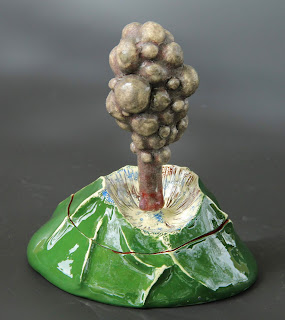 |
| Eruption Box, 2020, low fire ceramics, 5.5" h x 7"l x 5"w |
This week I finished glaze firing my boxes for Reminiscing On The Eruption: Mt. St. Helen’s 40th Anniversary exhibit at Oak Hollow Gallery, originally scheduled for April and May 2020. Now that we're all staying home, the show will have a virtual opening on May 18. Work is still for sale, and anyone interested can contact Oak Hollow Gallery for purchase and pick up.
 |
| Mount St. Helens Box Quartet, 2020 |
I've made five boxes, though two are really alternative versions of one another. The boxes show the mountain at different stages before, during, and after the eruption of May 18, 1980. Each of my boxes is about 5-7" wide and the tables is almost 7" tall.
 |
| After box, open. The interior and underside of the lid are finished with a cinnamon underglaze and a low fire glaze |
I finished the boxes using underglazes, low fire glazes, and some volcanic ash (or pumice) glaze mixed by some friends. After the eruption in 1980, Yakima, where I now live, was covered in a layer of volcanic ash. I've seen photos of people shoveling ash from the streets and the local museum has a display of various products where people apparently collected the ash and sold it in commemorative jar and other novelty items. In ceramics, ash glaze usually refers to wood ash, while pumice or pumicite is a name sometimes associated with volcanic ash in glazes. Anyway, regardless of the name, this experimental glaze has some volcanic ash in it.
 |
| Plume box (detail), with Mount St. Helens Ash glaze |
I used the volcanic ash glaze for the Eruption and Plume boxes. In both cases, I layered the under-fired ash glaze over some underglaze I had used to stain the cavities and intents of the sculpture. The glaze was under-fired because I fired it to a lower temperature than it was designed for.
 |
| Eruption box, opened to show the underside of the lid |
The ash glaze has a distinctive texture, especially applied and fired as I have done. It is semi-transparent in some places (probably because I combined it in some places with a low fire glaze). and the texture feels a bit sandy in others. There is a slight purplish grey color that may be a combination of the glaze itself and the underglaze underneath.
 |
| Before box, with cats, 2020, low fire ceramic, 4"h x 7" x 6" |
There was one piece that surprised me just a bit. I used a clear low fire glaze on the bottom of the Before box (with cats) but the lid of this piece has just a trace of the ash glaze mixed in. The difference isn't visible in the photo, but there is a very slight roughness to the glaze on the exterior of the lid when viewing or handling it in person.
 |
| Before box, without cats, 2020, low fire ceramic, 3.5"h x 6.5" x 5.5" |
I made two versions of the before box. One with the 16 cats that perished in the eruption and one without. The without version photographs a little nicer because of the matte surface, but I think I like the with cats version better in person.
 |
| After box, 2020, low fire ceramic, 3"h x 6" |
I didn't use any of the ash glaze on the Before boxes, but I did add a bit to the crater of the After box. This ash glaze is mixed with the low fire glaze, so the texture isn't so pronounced as that on the Plume, but the slightly purple/grey color is visible in the photo and the slightly rough texture can best be understood through touch.
 |
| Plume (1982) box, 2020, low fire ceramic, 6.5" x 5.5" x 4.5" |
The Plume box was only finished after firing when I epoxied the plume in place. I fired the plume separately because I was afraid of damaging it during handling and drying. Inside there is a metal and wood support epoxied to the lid and inside the plume.
 |
| Plume box, opened. This is based on a photo of Mount St. Helens from 1982 |
I'm happy with how the plume turned out. I may have lost a bit of applied texture when I covered the surface with the thick ash glaze, but I like the complicated color that seems to show up on the plume and the cracks or gaps that show up in the glaze surface. The texture of the sculpture is more visible in the solid cloud of the Eruption box, which is probably my favorite of the set.
 |
| Eruption box, the back side has underglaze color, the eruption itself has ash glaze, low fire glaze and underglazes together |
I plan to take these over to Oak Hollow this week, but first I've got to do my least favorite part of the process, price them for sale.










